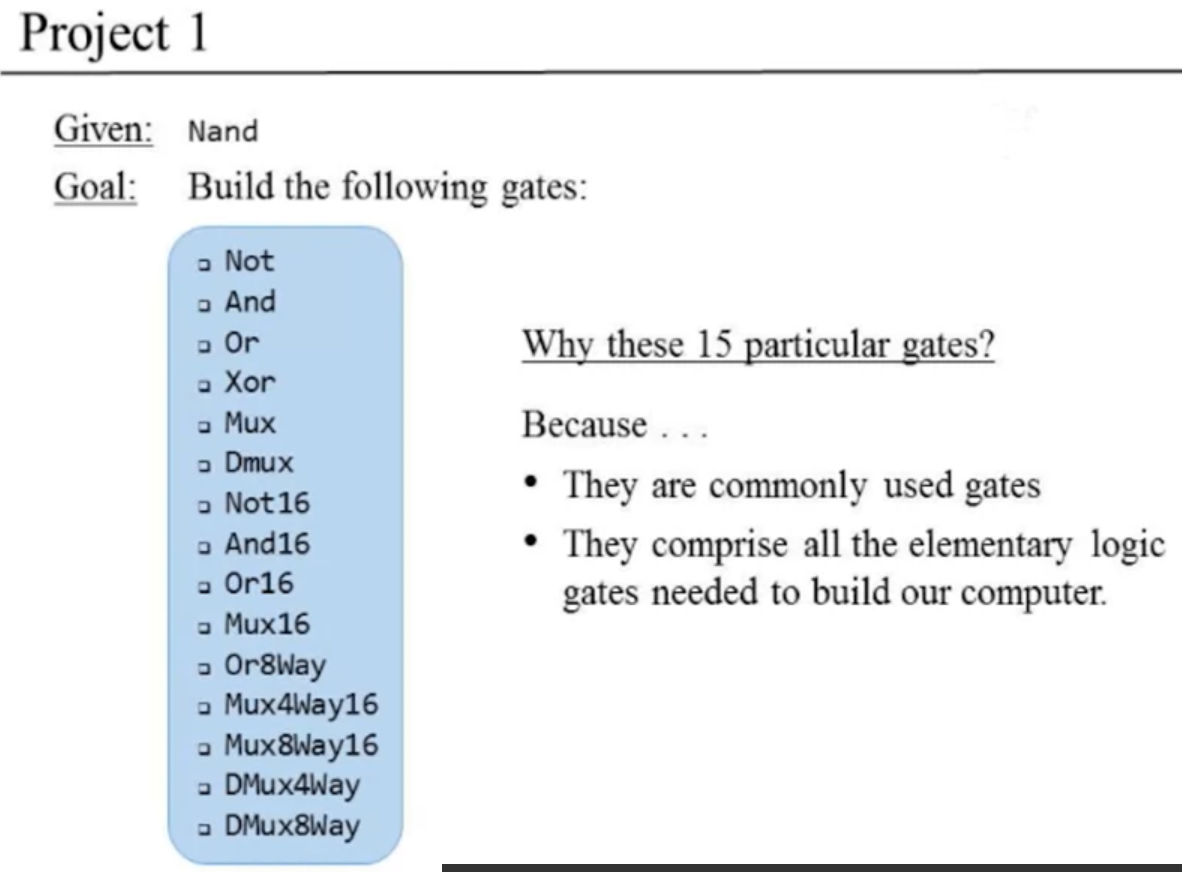Boolean Functions and Gate Logic
作业顺序

与非门 Nand
与非门是内置的,无需编写,可以直接使用,其他逻辑结构,在编写后才能使用。
A NAND B = NOT(A AND B)
与非门的真值表
| a | b | out |
|---|---|---|
| 0 | 0 | 1 |
| 0 | 1 | 1 |
| 1 | 0 | 1 |
| 1 | 1 | 0 |
其实只要构造出来其中一个常见的门(与或非),其他的都很容易推断出来。
非门 Not
非门只有一个输入,比较好猜想验证。
发现Nand两个输入相同时,会得到与输入端相反的结果。这就实现了非门。
// This file is part of www.nand2tetris.org// and the book "The Elements of Computing Systems"// by Nisan and Schocken, MIT Press.// File name: projects/01/Not.hdl/*** Not gate:* out = not in*/CHIP Not {IN in;OUT out;PARTS:// Put your code here:Nand(a=in, b=in, out=out);}
或门 Or
采用德摩根律
A Or B = not(not(A) and not(B))
// This file is part of www.nand2tetris.org// and the book "The Elements of Computing Systems"// by Nisan and Schocken, MIT Press.// File name: projects/01/Or.hdl/*** Or gate:* out = 1 if (a == 1 or b == 1)* 0 otherwise*/CHIP Or {IN a, b;OUT out;PARTS:// Put your code here:Not(in=a, out=nota);Not(in=b, out=notb);And(a=nota, b=notb, out=tmp);Not(in=tmp, out=out);}
数据选择器 Mux
两个提示点
a or 0 = a和a and 1 = a
// This file is part of www.nand2tetris.org// and the book "The Elements of Computing Systems"// by Nisan and Schocken, MIT Press.// File name: projects/01/Mux.hdl/*** Multiplexor:* out = a if sel == 0* b otherwise*/CHIP Mux {IN a, b, sel;OUT out;PARTS:// Put your code here:Not(in=sel, out=notsel);And(a=notsel, b=a, out=w1);And(a=sel, b=b, out=w2);Or(a=w1, b=w2, out=out);}
数据分配器 DMux
需要学会填充常数
a and 0 = 0和a and 1 = 1
// This file is part of www.nand2tetris.org// and the book "The Elements of Computing Systems"// by Nisan and Schocken, MIT Press.// File name: projects/01/DMux.hdl/*** Demultiplexor:* {a, b} = {in, 0} if sel == 0* {0, in} if sel == 1*/CHIP DMux {IN in, sel;OUT a, b;PARTS:// Put your code here:Not(in=sel, out=notsel);And(a=in, b=notsel, out=a);And(a=in, b=sel, out=b);}
16位-数据选择器 Mux16
第二部分就是许多简单门的并行,都是直接重复调用前面写好的简单门,HDL没有loop,不能简写。
// This file is part of www.nand2tetris.org// and the book "The Elements of Computing Systems"// by Nisan and Schocken, MIT Press.// File name: projects/01/Mux16.hdl/*** 16-bit multiplexor:* for i = 0..15 out[i] = a[i] if sel == 0* b[i] if sel == 1*/CHIP Mux16 {IN a[16], b[16], sel;OUT out[16];PARTS:// Put your code here:Mux(a=a[0], b=b[0], sel=sel, out=out[0]);Mux(a=a[1], b=b[1], sel=sel, out=out[1]);Mux(a=a[2], b=b[2], sel=sel, out=out[2]);Mux(a=a[3], b=b[3], sel=sel, out=out[3]);Mux(a=a[4], b=b[4], sel=sel, out=out[4]);Mux(a=a[5], b=b[5], sel=sel, out=out[5]);Mux(a=a[6], b=b[6], sel=sel, out=out[6]);Mux(a=a[7], b=b[7], sel=sel, out=out[7]);Mux(a=a[8], b=b[8], sel=sel, out=out[8]);Mux(a=a[9], b=b[9], sel=sel, out=out[9]);Mux(a=a[10], b=b[10], sel=sel, out=out[10]);Mux(a=a[11], b=b[11], sel=sel, out=out[11]);Mux(a=a[12], b=b[12], sel=sel, out=out[12]);Mux(a=a[13], b=b[13], sel=sel, out=out[13]);Mux(a=a[14], b=b[14], sel=sel, out=out[14]);Mux(a=a[15], b=b[15], sel=sel, out=out[15]);}
4路16位数据选择器 Mux4Way16
// This file is part of www.nand2tetris.org// and the book "The Elements of Computing Systems"// by Nisan and Schocken, MIT Press.// File name: projects/01/Mux4Way16.hdl/*** 4-way 16-bit multiplexor:* out = a if sel == 00* b if sel == 01* c if sel == 10* d if sel == 11*/CHIP Mux4Way16 {IN a[16], b[16], c[16], d[16], sel[2];OUT out[16];PARTS:// Put your code here:Mux16(a=a, b=b, sel=sel[0], out=tmp1);Mux16(a=c, b=d, sel=sel[0], out=tmp2);Mux16(a=tmp1, b=tmp2, sel=sel[1], out=out);}
8路16位数据选择器 Mux8Way16
调用上次的4路16位数据选择器,注意使用sub-bus时,中间是2个点,这个我点多了,没注意到这个错误。
// This file is part of www.nand2tetris.org// and the book "The Elements of Computing Systems"// by Nisan and Schocken, MIT Press.// File name: projects/01/Mux8Way16.hdl/*** 8-way 16-bit multiplexor:* out = a if sel == 000* b if sel == 001* etc.* h if sel == 111*/CHIP Mux8Way16 {IN a[16], b[16], c[16], d[16],e[16], f[16], g[16], h[16],sel[3];OUT out[16];PARTS:// Put your code here:Mux4Way16(a=a, b=b, c=c, d=d, sel=sel[0..1], out=tmp1);Mux4Way16(a=e, b=f, c=g, d=h, sel=sel[0..1], out=tmp2);Mux16(a=tmp1, b=tmp2, sel=sel[2], out=out);}
4路数据分配器 DMux4Way
这个我想了很久,也没有思路,还是查了别人的解法。类似从树的根开始递归遍历寻找in,需要剪掉的分支,直接赋予0,之后的递归全都是0了。
// This file is part of www.nand2tetris.org// and the book "The Elements of Computing Systems"// by Nisan and Schocken, MIT Press.// File name: projects/01/DMux4Way.hdl/*** 4-way demultiplexor:* {a, b, c, d} = {in, 0, 0, 0} if sel == 00* {0, in, 0, 0} if sel == 01* {0, 0, in, 0} if sel == 10* {0, 0, 0, in} if sel == 11*/CHIP DMux4Way {IN in, sel[2];OUT a, b, c, d;PARTS:// Put your code here://Dmux可以理解为sel = 0, 把in赋给前面,否则赋值后面DMux(in=in, sel=sel[0], a=w1, b=w2);//根据低位划分,低位符合的一组赋值为in,否则为0DMux(in=w1, sel=sel[1], a=a, b=c);DMux(in=w2, sel=sel[1], a=b, b=d);}
8路数据分配器 DMux8Way
sub-bus问题
这个姑且强调一下,也是看了论坛好多人问这个问题,虽然我没犯这个错误。
下标问题,比如c语言的字串,数组都是从左往右,下标依次增大的;
而本课程的HDL下标是从左向右,依次减小的,类似计算机组成原理中的大端(Big-Endian);
也因此,在递归处理8路数据分配器(拆成两个4路分配器)时,是从低位(右边)开始的,也就是调用时,几个参数是不连续的(这又类似低位交叉编址,误)
// This file is part of www.nand2tetris.org// and the book "The Elements of Computing Systems"// by Nisan and Schocken, MIT Press.// File name: projects/01/DMux8Way.hdl/*** 8-way demultiplexor:* {a, b, c, d, e, f, g, h} = {in, 0, 0, 0, 0, 0, 0, 0} if sel == 000* {0, in, 0, 0, 0, 0, 0, 0} if sel == 001* etc.* {0, 0, 0, 0, 0, 0, 0, in} if sel == 111*/CHIP DMux8Way {IN in, sel[3];OUT a, b, c, d, e, f, g, h;PARTS:// Put your code here:DMux(in=in, sel=sel[0], a=w1, b=w2);DMux4Way(in=w1, sel=sel[1..2], a=a, b=c, c=e, d=g);DMux4Way(in=w2, sel=sel[1..2], a=b, b=d, c=f, d=h);//吐槽,这里类似低位交叉编址。。。}
作业提交

总结
作业大约是从下午1点做到晚上8点,中间吃了2顿饭,去洗了一次澡,没思路就想看会手机。也算是大约和推荐的5h差不多吧。
回顾看一看代码量并不大,但是许多地方想写,会用自然语言或者c语言,但是并不能使用好HDL来写,确实有难度。
遇到不会的地方,想不懂的地方,也要去看看别人的思路。

